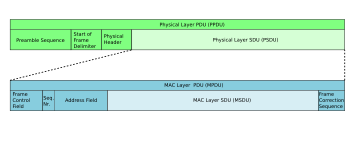Service data unit
Service Data Unit ( SDU ) and Protocol Data Unit ( PDU ) are concepts from the field of network protocols .
Network protocols are usually assigned to layers, for example according to the OSI layer model . Different hierarchical layers have different tasks. They each implement a protocol according to their task. The layers are usually numbered, with a number N .
Typically, each layer adds its own administrative information to the data to be transmitted. The complete set of data and management information of a layer N is called the Protocol Data Unit (PDU) of this layer. The PDU is the complete message that implements the Layer N protocol .
If this PDU is now transferred to a lower protocol layer N-1 , then from the point of view of layer N-1 it only represents the data which layer N-1 is to transmit. The layer N-1 provides the service ( Service ) prepared just those PDUs of layer N to be transmitted. Therefore, the data record to be transmitted (the PDU N ) on layer N-1 is also called the service data unit (SDU) of layer N-1 .
In summary, what's on layer N is the PDU is on the layer N-1 called the SDU - the layer of the N-1 to be transmitted data set that on layer N was formed. The simple formula means nothing else
PDU(N) = SDU(N - 1)
= PCI(N) + PDU(N + 1) + Footer(N)
= PCI(N) + SDU(N) + Footer(N)
Where Protocol Control Information - PCI (N) (header) and footer (N) represent the management information added by the Layer N protocol .
Conversely, it also follows from the formula
SDU(N) = PDU(N + 1)
What is called the SDU on level N is called N + 1 PDU on the level above .
In practice, PDU and SDU are often confused, or both are referred to as PDU. This is due to the fact that it depends solely on the shift on which you are (mentally) whether the same data record is a PDU or SDU.
The PDU is also often confused with the term payload data unit. The latter is out of focus defined and designated in inaccurate form, the 'payload' ( payload ) of a data packet - that which is strictly speaking the SDU on a layer. If the Payload Data Unit is then abbreviated to PDU, the risk of confusion is particularly high.
PDUs in relation to each of the first four layers of the OSI model:
- In layer 1 (physical layer) the PDU corresponds to the bit
- In layer 2 (data link layer) the PDU corresponds to the frame
- In layer 3 (network layer) the PDU corresponds to the package
- In layer 4 (transport layer) the PDU corresponds to the segment
From layer 5 , transferred content is referred to as data .
See also
literature
- John Dunlop, Demessie Girma, James Irvine: Digital Mobile Communications and the TETRA System. John Wiley & Sons LTD, Chichester 1999, ISBN 0-471-98792-1 .
- Gurdeep S. Hura, Mukesh Singhal: Data and Computer Communications. Networking and Internetworking, CRC Press LLC, Boca Raton 2001, ISBN 0-8493-0928-X .
- Alexander Prosser: Standards in computer networks. Springer Verlag, Vienna 1993, ISBN 978-3-211-82430-6 .
- Jean-Gabriel Rémy, Charlotte Letamendia: LTE Standards. John Wiley & Sons LTD, Hoboken 2014, ISBN 978-1-84821-588-7 .
Web links
- ISO-OSI reference model (accessed August 3, 2017)
- networking slide set (accessed August 3, 2017)
- Protocol TU Ilmenau Engineering Basics (accessed on August 3, 2017)
- Media Access Control (MAC) service specification (accessed August 3, 2017)
- Service data unit discard system for radio access networks (accessed on August 3, 2017)
